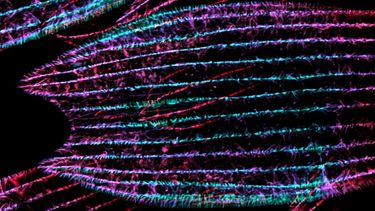-
The way in which the vibrant colours of butterfly wings are shaped has been revealed in a groundbreaking new study by researchers at the University of Sheffield
-
Using cutting-edge super resolution microscopy, Sheffield scientists and the Central Laser Facility, operated by the Science and Technology Facilities Council, have been able to investigate the developmental stages of butterfly scales, tracing their formation from caterpillar to butterfly
-
It is hoped the new findings regarding butterfly wing formation will help inspire the development of structural colour-based technologies for sensors and medical diagnostics
The secret of how butterfly wings get their vibrant colours has been revealed in a groundbreaking study.
Using cutting-edge super resolution microscopy, researchers from the University of Sheffield and the Central Laser Facility, operated by the Science and Technology Facilities Council, have been able to investigate the developmental stages of butterfly scales, tracing their formation from caterpillar to butterfly.
The new study, published in the journal Nature Communications, reveals that actin - a protein in butterfly’s scales - orchestrates the intricate arrangement of the colourful structures.
When comparing colourful scales to dull ones, Sheffield scientists noticed that the colourful ones had much denser actin bundles, creating more reflective ridges. Using powerful microscopes, the researchers watched as actin shifted during scale growth and colour formation, demonstrating how actin is crucial for creating butterfly colours, and is likely a universal process among all butterflies.
These structural colours can survive harsh environments, such as strong, direct sunlight, as there are no pigments to get bleached or damaged.
By investigating the mechanisms behind butterfly wing colouration, researchers hope to gain insights into broader areas of cell structure formation, including potential applications in sensing and diagnostics that could be important for a whole host of technologies including medicine.
The study also creates opportunities for the development of innovative technologies inspired by nature's own creations.
Structural colour-based technologies, mimicking the reflective properties of butterfly scales, hold promise in fields such as sensors and medical diagnostics, offering rapid and responsive solutions outside traditional laboratory-based approaches.
Dr Andrew Parnell, from the University of Sheffield’s Department of Physics and Astronomy, and lead author of the study said: “Actin is like a dressmaker, laying out and pinning the arrangement of these structures to shape the vibrant colours. Once the actin has finished its work it departs the cell like the removal of pins in dressmaking.
“Butterfly scale nanostructures are a powerful way in which to make long lasting bright colours that don’t fade or become bleached by the Ultra Violet (UV) rays of the sun. The museums of the world contain direct evidence of this. We need to transition to nature inspired ways to make such bright colours. This would be on a larger scale as new kinds of sustainable paints and coatings.”
Dr Nicola Nadeau, from the University of Sheffield’s School of Biosciences, and co-author of the paper said:“I find it fascinating that during metamorphosis, butterflies are able to produce these incredibly complicated structures that are so intricately patterned. Understanding how they do that and how it’s controlled by the machinery within the cell has given us new insights into how biological structures are formed more generally and how we might go about replicating those processes”
Dr Esther Garcia, from STFC Central Laser Facility, said: “As a microscopist, being part of this project has been incredibly exciting, we have visualised butterfly scales with an unprecedented level of detail. This research not only provides novel information on the tiny parts of these cells, but also constitutes a tool for other scientists interested in studying similar structures in other organisms.”
Dr Victoria Lloyd, Research Associate from the University of Sheffield’s School of Biosciences and first author of the paper, said: “Showing that disrupting actin removes the colour was key. It underscores the dynamic and indispensable role actin plays in producing the vibrant colours found in butterfly scales.”



